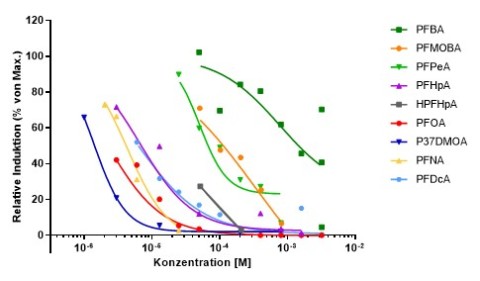UBA: The selection of the most suitable bioassays for PFAS detection
In PROMISCES, the German Environment Agency (Umweltbundesamt, UBA) has been tasked to assess the toxicity of PFAS and PMT substances in laboratory experiments. Based on previous experiments, 44 PFAS were selected to perform with different bioassays. The research indicated that TTR-TRβ CALUX bioassay showed the most promising results regarding detection of PFAS.
Using the results of the screening approach with a broad range of bioassays, the final selection of the most sensitive and suitable bioassays was made. The most promising bioassays to detect effects of PFAS were TTR-TR-CALUX, anti-AR-CALUX and the cytotoxicity module, consisting of tests for the proliferation of cells (RTCA) and the metabolism of cells (ATP). The 44 PFAS tested showed the most activities in the cytotoxicity module and the TTR-TRβ CALUX (35 active compounds in the RTCA, 36 active compounds in the ATP assay and 38 active compounds in the TTR-TRβ CALUX). Of the 28 PFAS tested in the anti-AR CALUX, 12 compounds revealed an activity. The toxicity profiles of these 44 PFAS using the enhanced bioassay battery demonstrated that the TTR-TRβ CALUX is the most responsive and sensitive bioassay compared to the other tests.
Moreover, it is noticeable that the effects of PMT substances are significantly lower than the effects of PFAS.
Furthermore, the relative potency factors (RPF) of the tested PFAS determined in vitro will be helpful in assessing PFAS based on their effects and identifying PFAS that pose a health risk but have not yet been evaluated for regulatory purposes.
This data indicates that in vitro toxicity analysis of unknown PFAS using in vitro bioassays is a promising and suitable strategy to predict the characteristics of complex mixtures, consisting of a few known PFAS but many other unknown PFAS.

Preliminary results of PFAS with the TTR-TR CALUX, based on the inhibitory effect on binding of T4 to the TTR molecule. @UBA, 2023
